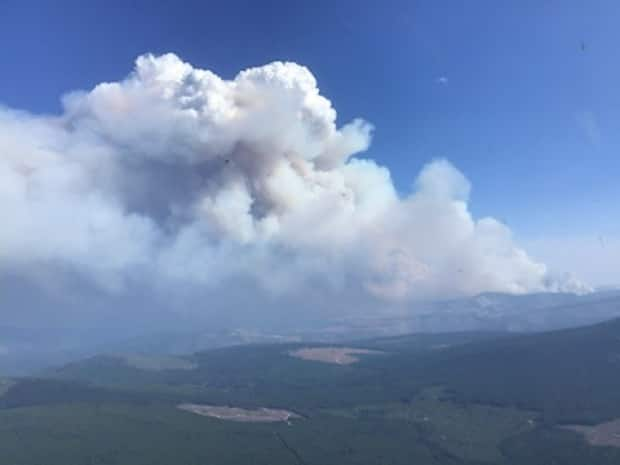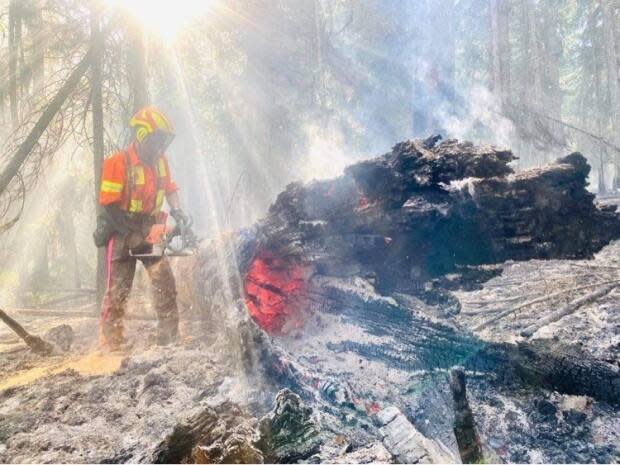Heavy smoke hampering firefighting efforts, choking B.C. Interior as 245 wildfires burn

Wildfire crews are battling a growing number of blazes across B.C., and they're also contending with heavy smoke that has blanketed large swathes of the province with dangerous pollutants.
As of Sunday morning, 245 wildfires are active in the province. The largest number are in the Kamloops Fire Centre, which includes the Okanagan region, accounting for nearly a third of B.C.'s fires. The number of fires has increased by 14 in the last two days.
More than 3,000 properties across the province have been ordered to evacuate, and at least 15 municipalities exceeded the province's maximum 24-hour air pollution exposures.
"Dense smoke continues to affect the Okanagan," Erika Berg, with B.C.'s wildfire service, told CBC News Network. "It means we have to be very strategic with where we station our aircraft, as well as where they are able to operate.... It does affect our operations ... our staff — their well-being, their safety — is our top priority.
"We take visibility very seriously."
The province's Interior region continues to suffer from wildfire smoke. Authorities are warning residents of serious health risks of long-term exposure to tiny airborne pollutants for the most vulnerable, including seniors and small children. Thirty-six of those communities have been under air quality advisories in place from earlier this week.

On Sunday, authorities also issued a special air quality statement for the entire Metro Vancouver and Fraser Valley region, warning residents are "likely to be impacted by wildfire smoke over the next 24-48 hours," according to the provincial environment ministry.
"Persons with chronic underlying medical conditions or acute infections such as COVID-19 should postpone or reduce outdoor physical activity until the advisory is lifted, especially if breathing feels uncomfortable," Metro Vancouver said in a statement Sunday afternoon,
The regional authority noted that exposure to fine airborne particles in wildfire smoke "is particularly a concern for people with underlying conditions," as well as seniors and infants.
Health risks
The smoke is so bad that south of the border numerous areas of the U.S. West were under air quality alerts on Sunday as B.C. wildfire smoke lingered. This includes the northern U.S. Rockies, including portions of Colorado, Wyoming, Washington state and Idaho.
Wildfires emit huge volumes of microscopic smoke particles that researchers say can be harmful, leading to both immediate and long-term health impacts.
A total of 5,050 square kilometres have burned so far this year in B.C.— a 45 per cent increase above the past decade's wildfire season average.
Wildfire smoke has worsened air quality to dangerous levels in many B.C. communities.
The worst-hit community has been Trail — which averaged 36 times the World Health Organization's maximum exposure amount over 24 hours — followed by the nearby Kootenay city of Castlegar, which exceeded WHO guidelines by 30 times over the last day. In the Okanagan region, Kelowna hit 29 times the maximum safe levels in that period.
Displaced by wildfires
People in several regions in B.C. remain forced out of their homes due to wildfires. There are currently more than 60 evacuation orders affecting more than 3,000 properties.
New orders were issued late on Saturday night for Queest Village and Pete Martin Bay north of Sicamous, B.C., as well as another order for the community of Eastgate southwest of Princeton on the Highway 3.
On Sunday, the Okanagan Indian Band issued an evacuated order for properties threatened by the White Rock Lake wildfire, which is burning 34 kilometres northwest of Vernon.
The Regional District of the Central Okanagan also raised an evacuation alert to an evacuation order on Sunday. It declared a local state of emergency in an area outside of Vernon known as Westshore Estates on Westshore Road.
The White Rock Lake fire has been burning since July 13 and is still classified as out of control. It has grown to 320 square kilometres. The evacuation orders issued Sunday are in addition to evacuation orders already in place for more than 100 other properties.
On Sunday officials reiterated the importance of not staying behind if an evacuation order comes for your property.
"Basically if you chose to remain in an area it puts yourself, your family and first responders in danger," said Michelle Nordstrom with the Thompson-Nicola Regional District.
"What we've been hearing from firefighters is it may be impeding fire crews from fighting fires. Evacuation orders are not issued lightly. They are important life-saving orders."

The Canadian Red Cross is providing financial assistance to people under an evacuation order for 10 consecutive days or more due to wildfires.
Both the province and federal government are matching donations made to the Canadian Red Cross to provide the support.
Eligible households across B.C. will receive $1,200.
Anyone placed under an evacuation order should leave the area immediately.
Evacuation centres have been set up throughout the province to assist anyone evacuating from a community under threat from a wildfire. To find the centre closest to you, visit the Emergency Management B.C. website.
Evacuees are encouraged to register with Emergency Support Services online, whether or not they access services at an evacuation centre.

